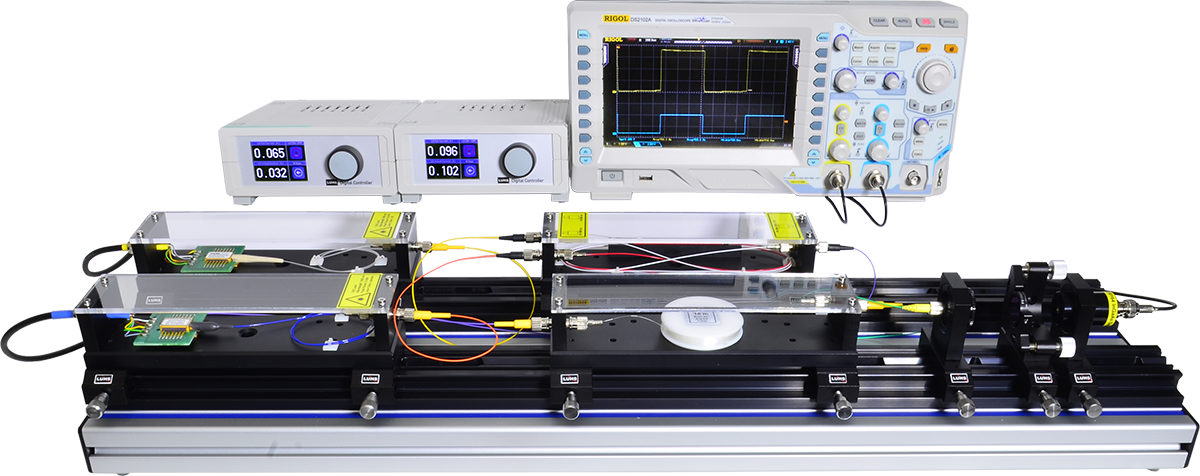Optical Amplifier
Optical Pumping
Erbium doped optical Amplifier
Coupling light to fiber
Signal Amplification
Fiber Laser
Lifetime of Excited State
Fiber Laser Spiking
Two photon excitation
LT-0300 Erbium doped Fiber Amplifier EDFA
Topics:
 LT-0300 Erbium doped Fiber Amplifier EDFA
LT-0300 Erbium doped Fiber Amplifier EDFA
The experiment uses two laser diodes, one emits a wavelength of 980 nm with a power of 300 mW and serves as pump source. The other emits a wavelength of 1550 nm with lower power around 5 mW and serves as signal source. Both diode laser are fiber coupled and are connected via single mode patch cables to the fiber coupler. The pump as well as the signal wave enter the Erbium doped fiber and the signals leaving the fiber are detected by a InGaAs photodetector. In order to detect only the 1550 nm radiation a laser line or interference filter is placed in front of the photodetector. Each diode laser has its own controller to set the individual injection current for the measurement of the EDFA as function of the pump and the signal power.
| Item | Code | Qty. | Description |
|---|---|---|---|
| 1 | CA-0060 | 1 | Infrared display card 0.8 -1.4 µm |
| 2 | CA-0450 | 3 | BNC connection cable 1 m |
| 3 | DC-0040 | 2 | Diode laser controller MK1 |
| 4 | DC-0164 | 1 | InGaAs Photodetector ST with connection leads |
| 5 | DC-0380 | 1 | Photodetector Junction Box ZB1 |
| 6 | MM-0020 | 3 | Mounting plate C25 on carrier MG20 |
| 7 | MP-0130 | 1 | Optical Bench MG-65, 300 mm |
| 8 | MP-0150 | 1 | Optical Bench MG-65, 500 mm |
| 9 | OC-0430 | 1 | Fiber jacket in C25 mount |
| 10 | OC-0760 | 1 | Laser line filter 1550 nm in C25 mount |
| 11 | OC-2010 | 3 | ST/ST SM Fiber patch cable, length 0.25 m |
| 12 | OC-2020 | 1 | ST/ST SM Fiber patch cable, length 1 m |
| 13 | OC-2230 | 1 | Erbium doped fiber unit, ST terminated, length 16 m |
| 14 | OC-2300 | 1 | SM-WDM coupler 980/1550 nm unit ST terminated |
| 15 | OM-0540 | 1 | Diode laser module 980 nm, ST fiber connector |
| 16 | OM-0550 | 1 | Diode laser module 1550 nm, ST fiber connector |
| 17 | UM-LT03 | 1 | Manual EDFA |
| Required Option (order separately) | |||
| 18 | CA-0200 | 1 | Oscilloscope 100 MHz digital, two channel |
| Media Type | Title | File Size [MBytes] | Action |
|---|---|---|---|
| LT-0300 Erbium doped Fiber Amplifier EDFA Version: 2022 |
3.28 MB | Download | |
| Catalogue Page | |||
| JPEG, PNG, SVG | Pictures | ||
| MP4 | Video |